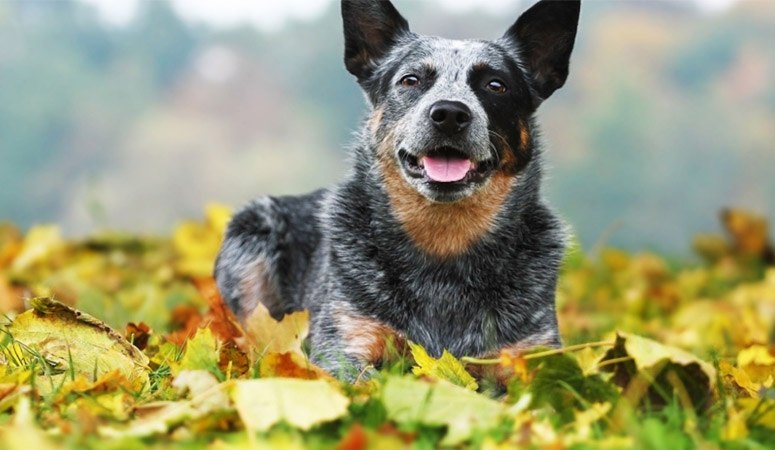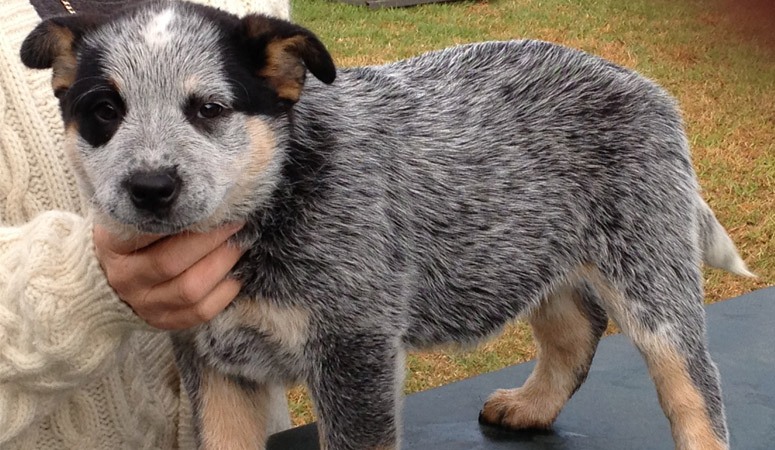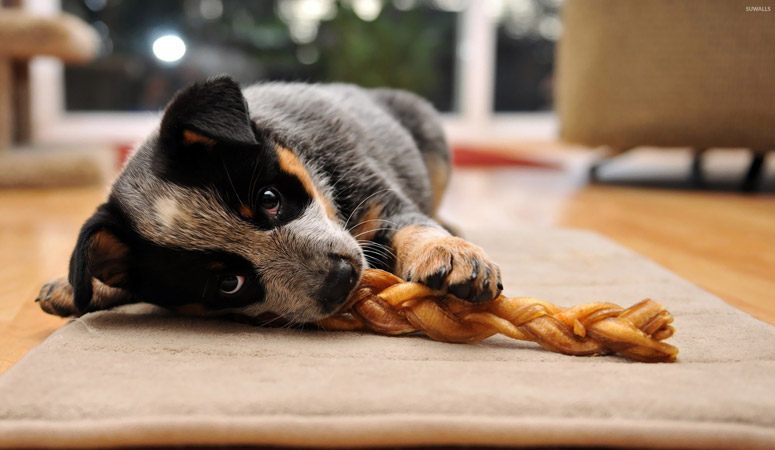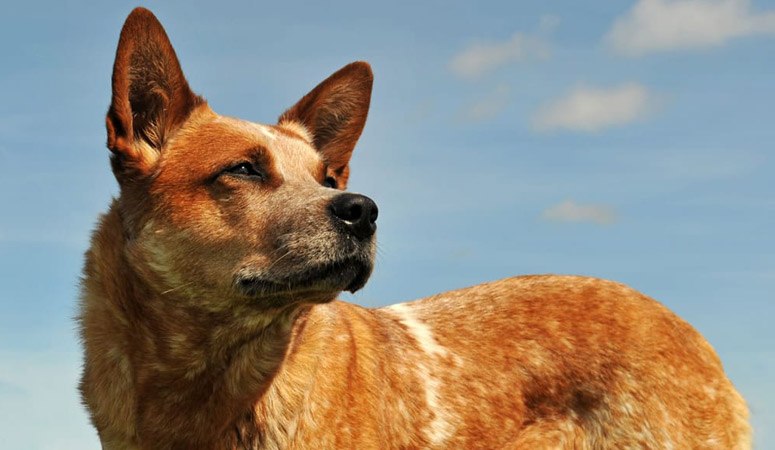Australian Cattle Dog
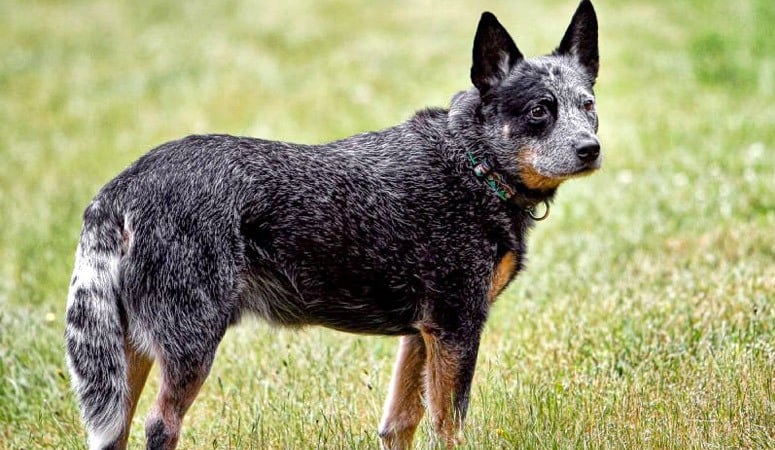
The Australian Cattle Dog is a very intelligent, active, and hard-working herding dog breed, which was developed from the wild dog of Australia – the Dingo. They can be conducted to agility, tracking, herding training, so they are popular as working dogs. This breed is not appropriate for a family who has children because a tendency to bite or nip is often present in the Cattle Dog.
| Other Names | Australian Heeler, Australischer Treibhund, Blue Heeler, Bouvier Australien, Boyero Australiano, Hall’s Heeler, Queensland Heeler, Red Heeler |
| Color | Blue, Blue Mottled, Blue Speckled, Red Mottled, Red Speckled |
| Height | Males: 18-20 inches. Females: 17-19 inches. |
| Weight | Males: 33-50 pounds. Females: 33-50 pounds. |
| Life Span | 12-16 years |
| Personality | Alert, Curious, Pleasant |
| Exercise | Needs Lots of Activity |
| Origin |
| Popularity | #55 |
| Groom Needs | Occasional |
| Kids Friendly | No |
| Dog Friendly | Yes with supervision |
| Watch Dog | |
| Family Dog | |
| Litter Size | 5-6 |
Australian Cattle Dog Pictures
Australian Cattle Dog Video
Introduction
Australian Cattle Dogs were developed for the purpose of cattle droving in 19th century Australia. With a short double coat and powerful limbs, imbued with the agility and strength of an Olympics hopeful, the Australian Cattle Dog makes a dandy picture of a wild cattle dog. They are easily bored, especially when there aren’t challenging tasks to perform, and are favored for their endurance. Their coat colors are blue, blue mottled, blue speckled, red mottled, and red speckled. Tan markings are also accepted by the AKC standard.
A standard Australian Cattle Dog is a medium-sized dog and, as such, a male is likely to stand at a shoulder height of between 18 and 20 inches, while a female approaches around 19 inches on the average. Despite the slight difference in height, males are mostly not any heftier than the females. Both sexes weigh between 36 and 48 pounds of weight, proportionate to the height.
Australian Cattle Dogs are alert, inquisitive, and playful. They have an average lifespan of 11-16 years.
Living with Australian Cattle Dog
The Cattle Dog has a close and waterproof coat that can protect him from the elements. An Australian Cattle Dog usually needs just a quick brushing once a week and an occasional bath because his coat has no odor or oily residue. But, the ACD sheds his undercoat twice a year, during this period, brush more frequently with a short-bristle brush and possibly a comb as well to remove the dead hair, and every few days he should get a bath.
Also, owners need to check the dog’s ears for signs of infection and clean them softly with a gentle cleanser. And brush your dog’s teeth at least two or three times a week to prevent gum disease and bad breath. Trim the nails once a month if your dog doesn’t wear them down naturally.
As the Australian Cattle Dogs are very active and high energy, they need more than just a quick walk and playtime in the yard. Actually, they really need a job to remain happy and healthy, especially work on a farm for herding animals. In other living situations, owners should let him walk at least twice a day and more than 45 minutes each time. If you are a jog-lover, the ACD can be a great companion for you.
Besides, taking the ACD to participate in dog sports is a great option, such as obedience or agility, this can guide the breed’s drive and abundant energy in a fun way
Generally, Australian Cattle Dogs need approximately one and a half to two and a half cups of high-quality dry dog food each day, divided into two meals. There should be clean fresh water at all times. Importantly, the food amount should depend on your dog’s weight, age, build, metabolism, and activity level.
Some dogs are easy to get overweight, so you need to watch their calorie consumption and weight level all the time.
Treats may be an important aid in training, but excessive intake can lead to obesity. Also, owners need to distinguish which human food is safe for dogs and which are not. If you have any problems with your dog’s weight or diet, just consult from your veterinarian.
Australian Cattle Dogs are prone to the following health conditions: Progressive retinal atrophy, Osteochondritis dissecans, Canine hip and elbow dysplasia, luxating patella, Deafness, Von Willebrand’s disease, Persistent pupillary membrane, Cataract…
Major concerns: OCD, CHD, PRA, elbow dysplasia, deafness
Minor concerns: none
Occasionally seen: lens luxation, vWD, cataract, PPM
Suggested tests:
Hip Evaluation
PLL DNA Test
BAER Testing
Elbow Evaluation
PRA Optigen DNA Test
Ophthalmologist Evaluation
Total Annual Cost: $2889
Cost is estimated for the first year and may vary depending on many factors, such as dog food, health care, leash, collar, licensing, possible fencing, crates, training and obedience classes, dog-walking, grooming, treats, toys, flea, tick, and heart-worm meds, microchips, etc.
It is recommended to start socialization and obedience training as early as possible for the Australian Cattle Dogs. As they are highly intelligent and energetic dogs that are really happy when on the job, continuing training and participation in activities such as obedience, herding, or agility are good choices. It is fun for both you and your pet to take part in the activities as it can foster a bond between you two. Because they are also independent, stubborn, and sensitive to harsh reprimands, they could learn best with plenty of positive patience and reward of dog treats. And owners need to remember that ACDs are highly energetic dogs, once they don’t keep occupied they will be bored and become destructive.
History
It is an established fact that the Australian Cattle Dog has an interesting Australian root. However, countries like the United States, England, and Canada have a fair share of their own stories with the Australian Cattle Dog. The earliest ancestors of the breed were developed in the 19th century in Sydney. At that time, cattlemen were tasked with herding their stock all the grueling distance and rugged plains to the market. The terrain was undulating and parched, made worse for the harsh conditions of the region.
There was a need for drover dogs that could bear these conditions and yet possess the features of a herding dog. Around the beginning of the 1800s, a cattle breeder named George Hall lived with his family in New South Wales Colony. Faced with the same challenges as his contemporaries, Mr. Hall was hard put to acquire a dog that was suitable for the purpose of cattle droving. He imported a number of drover dogs from Northumberland, where he grew up. The drover dogs served the purpose but had hardly broken into the mold of George Hall’s dream cattle dog.
He set out to cross-breed the Drover Dogs of Northumberland with his tamed dingoes. After several crosses, in the 1840s, Hall achieved what he supposed to be the perfect cattle dog for his purpose. He named them the Hall’s Heelers, for they followed closely on the heels of the cattle. They were used only by the Halls. These Hall’s Heelers are widely accepted as the ancestors of the Australian Cattle Dog.
The Hall’s Heelers were later improved upon by the Bagust brothers around the 1890s after the death of George Hall. The standard for the breeding of this breed was probably written by one Robert Kaleski, around 1882. The turn of the 20th century opened windows of opportunities for this breed to leave Australia for other countries, such as the U.S (in the 1940s), England, and Canada (in the 1980s) where they were further bred. The American Kennel Club fully recognized the breed in 1980.
Helpful Information
Breed Club: AUSTRALIAN CATTLE DOG CLUB OF AMERICA
Breed Club Link: http://www.acdca.org/
Breed Club Rescue: Australian Cattle Dog Rescue Inc.
Breed Club Rescue Link: http://www.acdrescueinc.com/

